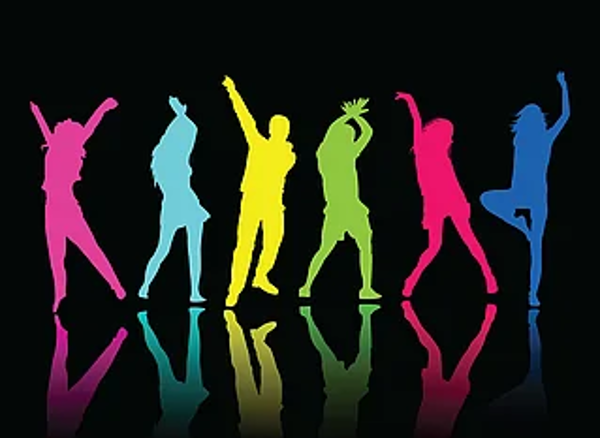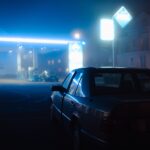by Janelle Sheetz
Every morning in high school, I stepped onto the bus and followed the aisle to my usual seat near the back. I sat and braced my knees on the seat in front of me, then dug through my bag for my portable CD player, so battered from frequent use that its silver paint was wearing off to expose plain plastic beneath. I adjusted my headphones—discolored from makeup—pressed play and settled in for the ride. When an album ended, I moved on to the next in my CD wallet, always in order, always with the liner notes tucked behind the disc.
My beloved CD wallet was an esteemed place, its finite slots reserved for the best in my collection. Whenever I got a new CD, I added it to the rotation. I flipped through discs whose track listings I knew by heart, looking for something I’d grown tired of to remove and return to its case in the CD tower in my bedroom. The new album would take its place. My favorites might stay in rotation for several months, the bulk of the school year even, before they were removed, if they were removed at all.
My time on the bus with my CD player in the early morning was sacred, and it began with pop punk.
“Can we listen to a CD while we work?” One of the girls asked our teacher.
She and her friends, a small clique in our Catholic middle school, sat huddled around a boom box. They were already deep into their emo phase, at least as much as one can be in Catholic school. For them, this typically meant when the opportunity arose—a dress-down day, outside of school, or just a subtle addition to our uniform—they wore Sid Vicious-style chokers, thick black eyeliner, studded belts and jewelry, and Converse shoes.
I glanced up from my desk as one song after another caught my attention. The growl of an electric guitar and a catchy chorus were not new to me. I was raised on my parents’ taste of a combination of classic rock and 80’s pop and new wave. But something about pop punk was new and exciting, like it was a genre tailored to me. I liked the CDs in my collection at home—pop stars like Britney Spears, Jennifer Lopez, and Mandy Moore—but often, I was bored by the end of a 12-track album.
I felt like I could never get tired of what I was hearing now. I needed to know what it was, but I couldn’t ask. This was middle school, after all. I wasn’t part of the clique—quite the opposite, in fact, due to preteen drama and mean-girl behavior like mutual sniping at each other in the early days of the Internet. Instead, as soon as I got home, I staked my claim on our family computer. I waited through the screeches of dial-up internet, and searched for every stray lyric I could remember, my brain desperately clutching the songs’ choruses. I opened LimeWire, which my mother insisted I not use lest she get sued, and downloaded as much as I could—Good Charlotte, The All-American Rejects, New Found Glory, Something Corporate— with each lyric snippet leading to a new band.
At the time, critics—particularly listeners who preferred more authentic punk—dismissed pop punk for leaning too hard into the pop aspect, diluting punk music into something more accessible and commercial. Others, though, considered it a gateway. “People will discover other music through those bands,” they’d say, and in my case, that was true. The Internet was a rabbit hole. I prowled message boards and devoured interviews in magazines dedicated to alternative music, taking note of bands’ influences, label mates, and tour openers, as well as what other fans liked.
I eventually clawed my way to the forefathers of alternative music with a little help from my parents. After hearing The Cure’s “Lullaby” playing in a Hot Topic, my mom rediscovered her love for the band and dug out her cassettes of other Cure albums, plus a stash of other post-punk darlings like Depeche Mode, The Smiths, and Echo & the Bunnymen. When my dad heard me listening to Good Charlotte in my room, he said he’d introduce me to real punk and bought me my first Sex Pistols and Ramones albums.
If this was the music I listened to now, I had to dress the part. I refined my wardrobe to consist of almost exclusively clothes from Hot Topic—the early heyday of Hot Topic, before its shelves included Disney merchandise and Funko Pop! figurines. I focused on shades of red and black and band tees, and when I could talk my mom into taking advantage of a sale, I snagged the occasional pair of bondage pants with clips and straps hanging down the legs. The Pacific Sunwear a few stores down in the mall yielded Dickies pants and shoes by Converse and Vans.
In the morning, I’d delay getting out of bed and getting ready for school as long as possible, and when I finally accepted I was running out of time, I’d turn on the small TV on my nightstand and flip through VH1, MTV, and my personal favorite, local college-run CUTV, known for playing blocks of alternative music and later bought by MTV and renamed MTVU. The channels still played music videos in the early-morning hours then, and as they played, I started my short, simple makeup routine—a layer of drugstore foundation to even out my skin tone, mascara to make my already naturally long eyelashes stand out even more, and thick black pencil eyeliner. I’d pull my hair back and leave two pieces loose to frame my face, at least until I fully embraced my natural curls and livened them up with a rinse. I wanted to dye my hair black, but my mother said no, just as she had a few years prior when I wanted blonde highlights like the other girls in school.
I often painted my nails black, occasionally with one finger a different color. I wore band hoodies on the bus in the morning over my uniform and striped knee-high socks no one would see anyway because I exclusively wore long pants, too insecure to expose my legs in the Catholic-schoolgirl staple of plaid skirts. In winter, I battled the insufficient heat of the school’s drafty old building with striped arm warmers. I made bracelets out of electrical tape and covered my school planner and notebooks with it. The straps of my (black, obviously) purse were covered with buttons with band names, sayings about being different, or characters from movies like The Nightmare Before Christmas and The Crow, and I bought a denim jacket and covered it in band patches—safety-pinned on rather than ironed, of course, for an added edge. I hauled my books in a black and red messenger bag styled in the face of the black cat from Emily the Strange.
I was figuring out who I was with suburban-mall punk as a blueprint. To me, at least, that meant rigidity—each subculture had its own defined look with no room for deviation or nuance, and therefore, identifying with one meant strict adherence to everything associated with it. Anything that didn’t fit my idea of it was abandoned or ignored moving forward. I dressed the way I liked, but with certain parameters. I already wore a uniform at school, and I essentially created one outside of school.
My new persona also came with a touch of elitism. I’d discovered something I thought was cool, I wanted like-minded people to think I was cool, and I looked down on others—specifically, girls—who were different. The worst, most uncool thing to be was a prep, but until then, that’s exactly what I was—a Limited Too and Claire’s girl whose favorite color was baby blue and who watched Legally Blonde over and over and over again. I purged any shred of evidence of this.
One Christmas, my brother and I sat on the floor in the living room, surrounded by bags and boxes of gifts from our parents and each other. I tore wrapping paper off a gift box and lifted the lid to reveal a small stash of new CDs. Among them was ABBA’s greatest hits—or rather, one of their greatest hits CDs, because ABBA has so many bangers that 19 songs just doesn’t do them justice, and I can admit that now. My mom had bought it for me, unaware that I wasn’t allowed to like ABBA anymore.
I hid my disappointment that I now had the very uncool, not at all punk ABBA in my CD collection as I skimmed through the track listing of familiar songs, many of which I really did love. But rather than letting it join my CD wallet, it languished in my mother’s car.
Whenever I was in my mom’s car, I insisted on listening to local alternative radio station, “The X”. She preferred to flip between radio stations, stopping for 80’s hits, classic rock, or whichever new musician caught her attention.
Some of my new favorite songs had great hooks—the pop aspect of pop punk that some had been so critical of made for some very catchy choruses—yet I’d decided that unless a song had an electric guitar, it was inferior. Even older bands like The Cure could do pop just as well as dark and moody. I listened to my mom’s cassette copy of Kiss Me, Kiss Me, Kiss Me just for the undeniably pop “Just Like Heaven” so often, she got sick of it.
“Let’s listen to something we can sing to.” My mother said one day, and instructed me to flip through her CD stash.
I rattled off the musical staples of her car—Prince, Stevie Nicks, the Kiss Me, Kiss Me, Kiss Me she’d had more than enough of. She stopped me when I got to ABBA.
“Ooh, yeah, put ABBA in!”
From the opening piano flourish of “Dancing Queen,” ABBA’s hooks gripped me, and they wouldn’t let go. I let the irresistible Swedish pop of Agnetha, Anni-Frid, Benny, and Bjorn wash over me. I even discovered new songs to love, like “Does Your Mother Know” and “Waterloo.”
I couldn’t deny it. I didn’t just love ABBA, I loved pop music, and I didn’t have a good reason to pretend otherwise. If I wasn’t going to limit myself to certain types of music, why keep arbitrary constraints on other aspects of my life? Loving ABBA made it okay to love other things and to be honest about it. Gradually, I stopped thinking about what articles of clothing or movies or books I was supposed to like and instead embraced whatever grabbed my attention, and my taste became more and more eclectic.
It was a strange form of self-acceptance, a way of being unapologetic about who I really was. I wasn’t the emo girl who only wore black and band t-shirts. I was other things, too, and those things didn’t deserve to be stifled. Pop punk steered me towards self-discovery—and bands I still adore now—but ABBA helped me to truly live on my own terms.
As a teen, I was full of shit. For the most part, the only person who cared so much about what I listened to or how I dressed was me. While people do often judge others’ tastes, no one was paying attention to what CDs I listened to on the bus or the fact that ABBA’s greatest hits was nestled among the likes of The Ramones. When I bought my band tees and bondage pants in Hot Topic, employees didn’t make me pass a test first. No one else was as concerned with such unrelenting authenticity, and if they were, their opinions didn’t really matter anyway.
There’s power in being honest about what you love, especially if it’s something you’re not supposed to love. It can be the most unexpected, counter-cultural, cool thing you can do. My eclectic taste in music, clothes, and damn near everything became a point of pride for me. I wasn’t put on this planet to deny things I love in the service of persona or image. While I’m here, I might as well have a good time, especially if that means being intimately familiar with the ABBA discography.
Early one morning, I got on the bus and sat in my seat, braced my knees in front of me, pulled out my CD player, adjusted my headphones, and pressed play. I skimmed through the albums in my CD wallet as it evolved, becoming more and more eclectic as my high-school years went by, and I smiled as the familiar opening chords of “Dancing Queen” rang out.
Janelle Sheetz (She/Her) lives with her husband and their son in the Pittsburgh area. Most recently, her work has been featured in Anti-Heroin Chic, Discretionary Love, and Motherwell. Her writing can also be found in Paste, HerStry, Ms. magazine, and more, and she is a regular contributor to entertainment website Collider. Find her online at JanelleSheetz.com.



Add your first comment to this post